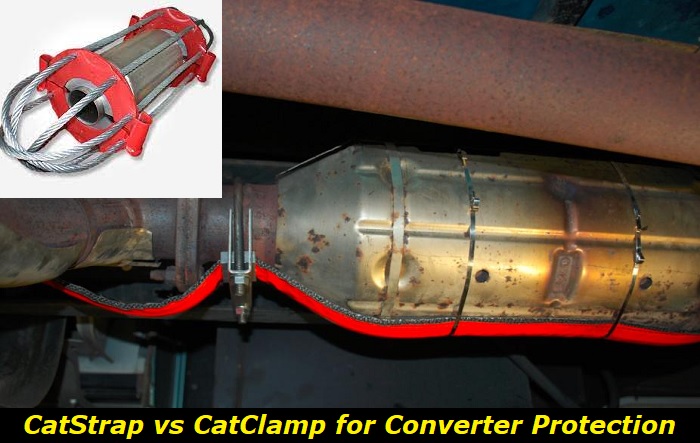The U.S. Environmental Protection Agency (EPA) mandated using catalytic converters to manage toxic vehicle emissions in 1975. A well-designed catalytic converter can reduce carbon monoxide and hydrocarbon emissions by up to 90%. However, a problem with catalytic converters is that they are vulnerable to theft. Depending on the car model, a catalytic converter theft could take under two minutes to complete, and replacing it is rather expensive.
Exhaust upgrades highlights
- Commonreasons:technical issues, power boost, delete
- Average prices:$300 - $3,000
- Average waiting time:1 - 9 days
- Common problems:emission test
- DIY mods:possible but quite complicated
- Level of satisfaction:low

Why Thieves Want Your "Cat" And Why You Should Protect It
Catalytic converters cut vehicle emissions by acting as a chemical reactant in filtering and transforming harmful exhaust gases from the engine into carbon dioxide, nitrogen, and water. In purifying exhaust, catalytic converters rely on precious metals - rhodium, palladium, and platinum, to convert harmful exhaust into a less toxic form.
As of the time of writing this article, an ounce each of Platinum, Palladium, and Rhodium is respectively $972, $1,362, and $10,200. The amount of these precious metals in a catalytic converter is small and will not get near the quoted values. Yet, the small amount of those precious metals found in a catalytic converter can still fetch a thief a decent payday if sold on the scrap market.
When sold as scrap, a catalytic converter will, on average, fetch between $100 and $500. However, costly catalytic converters can command over a thousand dollars when sold for scrap.
Another thing that makes a catalytic converter attractive to thieves is the relative ease of stealing one. With access to your car, a thief can sometimes cut off the catalytic converter from underneath the vehicle in less than two minutes. With cars that don't need jacking up, such as pickup trucks, catalytic converter theft can be faster. Further, a thief would not need a key or your cooperation to steal a converter.
The theft rate of catalytic converters rose by 109% between July 2021 and June 2022, totaling 43 219 total thefts.
With catalytic converter thefts rising, you must take extra measures to protect your catalytic converter because replacing one is expensive. Universal replacements for catalytic converters range between $200 and $300. But, if you use a newer vehicle that requires a direct-fit converter, the replacement cost might be up to $2500 or even beyond.
There are many ways to secure your catalytic converter, and below, we assess two anti-theft solutions - CatStrap and CatClamp.
CatStrap
CatStrap is a steel barrier that lays across the entirety of the vehicle's exhaust. The CatStrap is a heat-resistant, straight adhesive strap consisting of fiberglass and steel cables. The installation process should take around 30 minutes. While you can install it yourself, CatStrap recommends professional installation. After installing the CatStrap, it bonds with the exhaust pipes through the heat generated, which will cause a burning smell. The smell disappears after 2-3 days.
The CatStrap provides an extra layer of protection over the catalytic converter. CatStrap is a barrier between your catalytic converter and a saw or any other instrument thieves might use to cut it. Essentially, to cut off the catalytic converter, a thief would first need to cut the CatStrap. Cutting the CatStrap requires more effort, even with specialized hardware like a mechanical saw, than if it were the catalytic converter alone.
As a result, the CatStrap helps to secure your catalytic converter to some extent. Anyone who wants to remove the CatStrap will spend up to a minute more cutting off both the CatStrap and the catalytic converter. That alone might be all the deterrent you need, as most thieves will not want to increase the risk of getting caught while battling the CatStrap.
CatClamp
CatClamp's anti-theft protection for catalytic converters takes a very different approach from CatStrap. The CatClamp has two main components; split clamps and aircraft-grade wires.
There are two split clamps, one put before and the other after the catalytic converter. After installing the split clamps, route the wires through openings in the split clamps and through solid areas of the vehicle's chassis for more fidelity. Then, redirect the cables will back through the split clamps again. The wire must pass through each of the eight holes in each split clamp.
The wires that secure the catalytic converter are solid aircraft-grade wires that will not easily break if attacked with a knife or a hand saw. Cutting just a few cables with a mechanical saw will take some effort. For a thief to successfully reach the catalytic converter, they must cut most of the wire at the eight points it runs through both split clamps. The time it takes to get through the CatClamp will discourage most thieves.
Also, someone will likely get alerted by the noise generated in trying to cut through the CatClamp before any thief is successful.
CatClamp vs. CatStrap
This section will compare these two products' efficacy, price, and ease of installation.
1) Efficiancy
Neither CatStrap nor CatClamp will completely stop a determined thief with enough time from stealing your catalytic converter. However, both can discourage most catalytic converter thieves due to the additional effort and time required and the much-increased risk of getting caught. The question is which one performs that task better.
While CatStrap and CatClamp are effective at frustrating thieves and preventing converter thefts, the CatClamp's many points of failure give us more confidence.
The CatStrap single attachment along the exhaust pipe means thieves must focus on getting through the CatStrap. Cutting through the CatStrap is similar to how they would need to cut through just the catalytic converter. The difference between cutting just the catalytic converter and one with CatStrap is the added difficulty and time it will take.
In our opinion, the CatStrap does not look difficult to penetrate, even though it is. Seeing the CatStrap may not immediately dissuade a thief.
In a test by Donut Media, the CatStrap only added a minute and fifteen seconds to the process of stealing a catalytic converter. But it might take longer with a different car and in a less controlled environment.
In the same test, it took at least 2 minutes longer than usual to steal the catalytic converter with the CatClamp installed. Its many points of failure and the fact that the CatClamp attaches to parts of the vehicle's chassis make it challenging to access the catalytic converter.
The CatClamp's solid-looking wires running along multiple points around the catalytic converter look more problematic and intimidating than the CatStrap.
Both solutions help secure your catalytic converter, but the CatClamp is better, in our opinion.
2) Cost
Regarding cost, the CatStrap for gasoline and hybrid vehicles is $159.99 for a seven-foot-long strap, and the price for a diesel vehicle rises to $209.99 for a twelve-foot-long strap. Alternatively, the universal standard CatClamp for gasoline and diesel engines costs $181 and $396, respectively.
Model-specific CatClamps for heavy-duty trucks range from $375 to $748. While model-specific heavy-duty diesel engine CatClamps could cost up to $919, which is quite expensive. Even the costliest bundle from CatStrap for diesel engines with the CatEye electronic alarm only costs up to $319.99. If price is important to you, you may want to consider CatStrap.
Please note that we derived the prices listed above from both companies' official stores at the time of writing. Thus, prices may vary with time and where you buy them.
3) Ease of Installation
Both the CatStrap and CatClamp are pretty straightforward and quick to install. Suppose you carefully follow the installation instructions for both of them and have the necessary tools. In that case, both the CatStrap and CatClamp are installable within an hour. However, the CatStrap is the more straightforward of the two to install and should take less time.
Additional steps to take to protect your catalytic converter
- Park Your Car Selectively - catalytic converter thieves must get under your vehicle to steal it. So, where and how you park could deter thieves. If possible, park your car in a locked garage with reinforced doors. Supposing you don't have a garage or are away from home, park the part of your car where the catalytic converter is beside a wall, fence, or another vehicle. Doing this will complicate an attempted theft.
- Consider A Different Anti-Theft System - we have already mentioned two anti-theft systems - CatClamp and CatStrap. But there are other anti-theft systems you should consider as a supplement or alternative. There are alarm systems for catalytic converter protection, like CatEye from CatStrap. Also, you can check out Cat Shield, a product that covers the catalytic converter entirely with steel and aluminum shields. Or, you can get a welder to build a cage around your catalytic converter.
- Get Your Catalytic Converter Marked - find an auto shop nearby and seek their assistance in inscribing a serial number on your catalytic converter for identification. While scrupulous scrap dealers may ignore the serial number, the scrap metal dealers act requires scrap dealers to check the seller's identity against the parts identification code.
Conclusion
Both the CatClamp and CatStrap are effective means of securing a catalytic converter. In this article, we compared them using three metrics. The CatStrap sneaks out on top of pricing and ease of installation. Yet for us, getting the most effective anti-theft system for your catalytic converter is imperative. For that, CatClamp has the edge.
The CatClamp and CatStrap are not the only anti-theft methods available for your catalytic converter. Please explore some of the other options. You should also be conscious of your environment and where you park your car. Remember, prevention is better than cure. Today, catalytic converter replacements can be costly.
About the authors
The CarAraC research team is composed of seasoned auto mechanics and automotive industry professionals, including individuals with advanced degrees and certifications in their field. Our team members boast prestigious credentials, reflecting their extensive knowledge and skills. These qualifications include: IMI: Institute of the Motor Industry, ASE-Certified Master Automobile Technicians; Coventry University, Graduate of MA in Automotive Journalism; Politecnico di Torino, Italy, MS Automotive Engineering; Ss. Cyril and Methodius University in Skopje, Mechanical University in Skopje; TOC Automotive College; DHA Suffa University, Department of Mechanical Engineering






Add comment